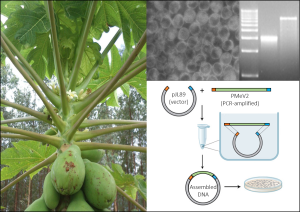Prelecionista: Anelise Franco Orílio (Pós-Doutoranda DFP/UFV). Data: 02/02/2021, às 16:00 horas, pelo canal do YouTube (pos.fitopatologia UFV) Link: https://www.youtube.com/channel/UCCZZh5mUepI3YHAYxBuU7qw. Supervisor: Francisco Murilo Zerbini.
Papaya sticky disease (PSD) is one of the main constraints of papaya production in Brazil and, more recently, has emerged as a serious problem also in Mexico. The sticky aspect of infected papaya fruit after latex oxidation by exposure to the air led to the name sticky disease, or meleira in Portuguese. The causal agent of PSD was tentatively identified in the 1990’s as an isometric virus. Subsequent work in the early 2000’s confirmed the causal relationship and showed that the virus, named papaya meleira virus (PMeV), has a double stranded RNA (dsRNA) genome. PMeV is most closely related to mycoviruses of the Totiviridae family. Recently, a second virus, with a single-stranded RNA (ssRNA) genome, was also shown to be associated with PSD. This virus, named papaya meleira virus 2 (PMeV2), has sequence identity with members of the genus Umbravirus (family Tombusviridae). Umbraviruses do not encode a coat protein and, consequently, do not form conventional virus particles. Genome encapsidation and transmission requires a helper virus. In Brazil, all papaya plants displaying typical PSD symptoms have a double infection with PMeV and PMeV2, with the PMeV2 genome encapsidated in the coat protein produced by PMeV. Papaya plants infected by PMeV alone do not show any symptoms. In Mexico, only PMeV2 has been identified so far, suggesting that either a dsRNA virus related to PMeV is present but has not yet been detected, or that PMeV2 moves systemically within infected plants and is transmitted from plant to plant as a free RNA. Reports that PSD can be seed transmitted in Mexico appear to support the second hypothesis, although a dsRNA band similar in size to the genome of PMeV has been detected in infected plants. The molecular mechanisms involved in the interaction between the two viruses and in the development of sticky symptoms have not yet been clarified. Infectious cDNA clones of PMeV and PMeV2 would be a powerful tool to study the biology of these viruses and of the virus-host interaction. An infectious clone is a full-length DNA/cDNA clone from which infectious transcripts can be obtained in vitro or in vivo with a suitable promoter. The objective of this seminar is to present the recent advances in the study of papaya sticky disease and the work being carried out at UFV in the development of the infectious clones of PMeV and PMeV2.
References:
Kitajima, E. W., Rodrigues, C. H., Silveira, J. S., Alves, F., Ventura, J. A., Aragao, F. J. L., and Oliveira, L. H. R. 1993. Association of isometric viruslike particles, restricted to lacticifers, with “meleira” (sticky disease) of papaya (Carica papaya). Fitopatologia Brasileira 18:118-122
Maciel‐Zambolim, E., Kunieda‐Alonso, S., Matsuoka, K., De Carvalho, M., and Zerbini, F. 2003. Purification and some properties of Papaya meleira virus, a novel virus infecting papayas in Brazil. Plant Pathology 52:389-394.
Perez-Brito, D., Tapia-Tussell, R., Cortes-Velazquez, A., Quijano-Ramayo, A., Nexticapan-Garcez, A., and Mart´ın-Mex, R. 2012. First report of papaya meleira virus (PMeV) in Mexico. African Journal of Biotechnology 11:13564-13570.
Sá Antunes, T. F., Amaral, R. J. V., Ventura, J. A., Godinho, M. T., Amaral, J. G., Souza, F. O., Zerbini, P. A., Zerbini, F. M., and Fernandes, P. M. B. 2016. The dsRNA virus papaya meleira virus and an ssRNA virus are associated with papaya sticky disease. PLoS One 11:e0155240. (Fotos)
Sá Antunes, T. F., Maurastoni, M., Madroñero, L. J., Fuentes, G., Santamaría, J. M, Ventura, J. A., Abreu, E. F., Fernandes, A. A. R. and Fernandes, P. M. B. 2020. Battle of three: The curious case of papaya sticky disease. Plant disease 104:2754-2763.

